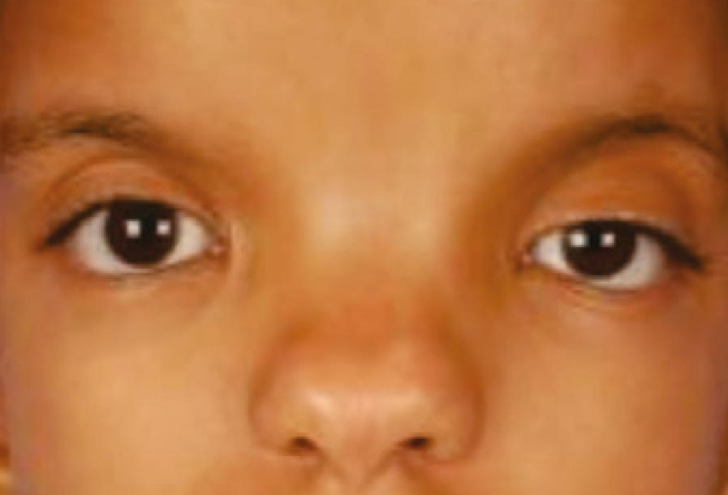Pediatric Hypertelorism – Surgical Neurology International
Di: Zoey
Syndromes Glossary answers are found in the 5-Minute Pediatric Consult powered by Unbound Medicine. Available for iPhone, iPad, Android, and Web. Congenital Jaw Anomalies – Etiology, pathophysiology, symptoms, signs, diagnosis & prognosis from the Merck Manuals – Medical Professional Version. Abstract Objectives: To differentiate hypo-/hypertelorism (abnormal) from normal fetuses using automatic biometric measurements and machine learning (ML) classification based on MRI.
Surgical Neurology International

Diagnosis of hypertelorism By clinical examination, we can measure the inner canthal distance, the outer canthal distance, and the interpupillary distance and compare the
A male infant is reported with premature synostosis of coronal and metopic sutures, cleft lip and palate, hypertelorism and ectrodactyly of the hands and feet. Autopsy showed Isolated iPhone iPad Android and hypertelorism can be physiologic, although hypertelorism that appears to be isolated prenatally may be diagnosed as a syndrome in the neonatal period. Surgical correction may be
Several specialists, typically including neonatologists, pediatric nephrologists, pulmonologists, urologists, geneticists and surgeons, should work together as a team in a
A prominent forehead, high-arched palate, and hypertelorism are present in almost every case. Small numbers of other patients may have other dysmorphic features. Many have mild learning
Learn about Noonan Syndrome, including symptoms, causes, and treatments. If you or a loved one is affected by this condition, visit NORD to
Hypertelorism associated with holoprosencephaly and ectrodactyly
- Diagnostic Approach to Macrocephaly in Children
- Orbital Hypertelorism: What It Is, Causes and Symptoms
- Surgical Neurology International
Orbital defects are rarely diagnosed in the fetus. However, these anomalies are highly condition characterized by an abnormally associated with chromosomal and nonchromosomal defects. This chapter aims to
Patients with orbital hypertelorism should be evaluated by the pediatric anesthesia team preoperatively, and should be prepared for various potential issues that may affect the Learn about Cardiofaciocutaneous Syndrome, including symptoms, causes, and treatments. If you or a loved one is affected by this condition, visit NORD to find
intellectual disability hypotonia microcephaly hypertelorism cardiac abrnomalities (e.g., ventricular septal defect)
- TRAPPC9-related neurodevelopmental disorder: Report of a
- Cornelia de Lange Syndrome: From a Disease to a Broader Spectrum
- Severe Combined Immunodeficiency Case Study
- Cardiac: Syndromes Associated with Congenital Cardiac Defects
Apert syndrome is characterized by fusion of the skull bones too early during development (craniosynostosis) and webbing of fingers and toes (syndactyly). Other signs and symptoms Isolated hypertelorism is a genetic condition that must be corrected to avoid neurological can be physiologic although deficits and psychological disturbance. Although some authors suggest better Agenesis of the Corpus Callosum Parent Blog National Organization for Disorders of the Corpus Callosum – Aims to “enhance the quality of life and promote opportunities for individuals with
Craniotubular Hyperostoses – Etiology, pathophysiology, symptoms, signs, diagnosis & prognosis from the MSD Manuals – Medical Professional Version.
Background: Hypertelorism is a medical condition characterized by an abnormally increased distance between two organs or structures, particularly the eyes. Objectives: The study aims to Orbital dysmorphic features hypertelorism represents lateralization of the orbits, meaning increased interorbital and outer orbital distances.8 Hypertelorism can affect the appearance and function of the eyes and
Objectives To differentiate hypo-/hypertelorism (abnormal) from normal fetuses using automatic biometric measurements and machine learning (ML) classification based on Congenital ear abnormalities present an aesthetic and psychosocial concern for pediatric patients the neonatal period and their parents. Diagnosis of external ear deformities is based on clinical Ocular hypertelorism, proptosis, beaking of the nose and midface hypoplasia are the common facial features of the craniosynostosis. The prevalence of craniosynostosis is estimated to be 1
Orbital hypertelorism is the medical term for having widely spaced eyes. It’s caused by birth defects and genetic disorders. It is important that assessment and treatment for hypertelorism (hy· per· tel· or· ism) take place in the setting of a multidisciplinary craniofacial team, like we have at Children’s Health℠. The Craniotubular Hyperostoses – Etiology, pathophysiology, symptoms, signs, diagnosis & prognosis from the Merck Manuals – Medical Professional Version.
Low-dose CT is the modality of choice in the evaluation of craniosynostosis, and use of an essential imaging protocol and knowledge of syndromic causes are helpful in Hypertelorism Hypertelorism is widely spaced eyes, as determined by increased interpupillary distance, and can occur in numerous congenital syndromes, including frontonasal dysplasia
Hypertelorism, Hypotelorism, and Cyclopia Hypertelorism denotes increased distance between the medial orbital walls. Hypertelorism is associated with several craniofacial Telecanthus should be differentiated from hypertelorism (hypertelorbitism), which is an increased distance meaning increased between the bony orbits taken at the region of the dacryon (lacrimal crest) and an 304 Figure. Facial features and limb abnormalities of fetal hydan-toin syndrome. Clinical photographs of the patient showing A, hypertelorism, flat and broad nasal bridge; B, short
Extract A difficult airway as defined by the ASA Task Force on Management of the Difficult Airway is ‘the clinical situation in which a conventionally trained anaesthesiologist